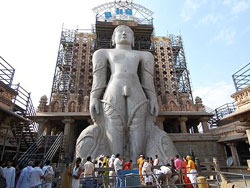
कर्नाटक राज्य में बैंगलोर के 120 किलोमीटर पश्चिम में श्रवणबेलागोला का पहाड़ी, जैनों के लिए तीर्थ यात्रा का एक प्रसिद्ध स्थान है। बड़े पहाड़ी, जिसे विंधीगिरि या प्रति-कालबाप्पु कहा जाता है, समुद्र तल से 3347 फीट ऊपर है। 614 कदमों की एक उड़ान, पहाड़ी की ग्रेनाइट में बारीकी से गढ़ी हुई, शिखर सम्मेलन की ओर जाता है, जहां एक खुली अदालत और श्री गोमेतेश्वर की महान मूर्ति है। सवर्णबेलागोला का अर्थ है 'पहाड़ी के शीर्ष पर भिक्षु' और कम से कम तीसरी शताब्दी ईसा पूर्व के बाद से ही भक्तों, रहस्यवादियों और साधुओं का निवास किया है। उन शुरुआती समय में पहाड़ी मोटे तौर पर वृक्षारोपण किया गया था और जवानों ने जंगल के व्याध से खुद को खिलवाया था। 10 वीं शताब्दी ईस्वी के मध्य में, पहाड़ी पर मंदिरों का निर्माण शुरू हुआ और उस समय से यह जगह जैन धर्म की सबसे महत्वपूर्ण तीर्थस्थलों में से एक बन गई है। 9 58-99 3 ईस्वी के बीच की पहाड़ी के ग्रेनाइट आधार से 58 गोदाश्त, 8 इंच की मूर्ति की प्रतिमा, दुनिया में सबसे बड़ी खड़ी प्रतिमा है। श्री गोमेतेश्वर, जिन्हें बाहुबली भी कहा जाता है, पौराणिक प्रथम तीर्थंकर के पुत्र थे, आदिनाथ (तीर्थंकर, पौराणिक, जैन धर्म के प्रबुद्ध ऋषि हैं)। श्रवणबेलागोला का मुख्य त्योहार महा माथाक अभिषेका या 'प्रमुख अभिषेक समारोह' कहा जाता है। त्योहार से पहले एक विशाल लकड़ी का मचान श्री गोमेतेश्वर की मूर्ति के चारों ओर बनाया गया है और दस लाख से अधिक तीर्थयात्रियों ने पवित्र पहाड़ी की ढलानों के आसपास और इकट्ठा किया है। त्योहार के चरमोत्कर्ष के दौरान, मठ मूर्ति के ऊपर खड़े पुजारी और भक्त मूर्ति के सिर पर हजारों गैलन दूध, शहद और कीमती जड़ी बूटियां डालते हैं। मूर्ति के शरीर पर नीचे बहते समय ये पवित्र प्रसाद माना जाता है कि महान देवता से आध्यात्मिक ऊर्जा का शक्तिशाली प्रभार प्राप्त करना है। मूर्ति के पैरों पर एकत्रित और तीर्थयात्रियों के इंतजार की भीड़ को वितरित करने के लिए, जादुई उपहारों को ज्ञान के लिए अपनी खोज में व्यक्तियों की सहायता करने के लिए माना जाता है। महोत्सव दुर्लभ ज्योतिषीय महत्व के दौरान बारह से चौदह वर्ष में केवल एक बार किया जाता है। हाल के त्योहारों में फरवरी 1 9 81 और दिसंबर 1993 में हुई।
The hill of Sravanabelagola, 120 kilometers west of Bangalore in the state of Karnataka, is a noted place of pilgrimage for the Jains. The large hill, also called Vindhyagiri or Per-kalbappu, is 3347 feet above sea level. A flight of 614 steps, finely chiseled into the granite of the mountain, leads to the summit, where stands an open court and the great statue of Sri Gomatheswar. Sravanabelagola means 'the monk on the top of the hill' and hermits, mystics and ascetics have resided here since at least the 3rd century BC. In those early times the hill was thickly wooded and hermits could feed themselves from the vegitation of the forest. Near the middle of the 10th century AD, temples began to be constructed upon the hill and from that time the place has become one of the most important pilgrimage sites of the Jain religion. The 58 foot, 8 inch statue of Sri Gomatheswar, carved between 978-993 AD, out of the granite bedrock of the mountain is the tallest free-standing statue in the world. Sri Gomatheswar, also known as Bahubali, was the son of the legendary first Tirthankara, Adinatha (tirthankaras are the mythical, enlightened sages of Jainism). The chief festival of Sravanabelagola is called Maha Masthaka Abhisheka, or the 'Head Anointing Ceremony'. Prior to the festival an enormous wooden scaffolding is built around the statue of Sri Gomatheswar and more than one million pilgrims assemble around and upon the slopes of the sacred hill. During the climax of the festival, priests and devotees standing atop the scaffolding chant holy mantras and ritually pour thousands of gallons of milk, honey and precious herbs over the head of the statue. While flowing downwards over the body of the statue these sacred offerings are believed to acquire a powerful charge of spiritual energy from the great deity. Collected at the feet of the statue and distributed to the throngs of waiting pilgrims, the magical libations are considered to assist individuals in their quest for enlightenment. The festival is performed only once every twelve to fourteen years during periods of rare astrological significance. Recent festivals occurred in February 1981 and December 1993.